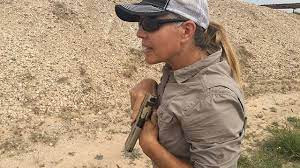When it comes to pistol shooting, understanding and mastering various shooting positions can significantly enhance safety and performance. The low- and high-ready positions are fundamental stances both amateurs and professionals utilize for different circumstances. Let's explore these positions, their pros and cons, and how to train for each.
Understanding the Positions
Low-Ready Position
Description
In the low-ready position, the shooter holds the firearm pointed downwards at a 45-degree angle, with the arms relatively extended, allowing for rapid alignment to a target if necessary.
Pros
- Safety: By pointing downwards, you mitigate the risks of accidental discharge hitting unintended targets.
- Readiness: It offers a quick transition to a shooting stance, allowing a shooter to respond to threats efficiently.
Cons
- Limited visibility: Holding the pistol lower can slightly restrict the visual on the potential threat.
- Potential for muzzle obstructions: There's a slight chance that the muzzle could be obstructed by debris or hit obstacles when raised hurriedly.
High-Ready Position
Description
The high-ready position involves holding the pistol near the chest or head level, with the muzzle elevated and pointed upwards, enabling a clear view of the surroundings while maintaining a firm grip on the weapon.
Pros
- Enhanced visibility: This position provides a better field of view compared to the low-ready position.
- Quick Target Acquisition: Allows for quicker target acquisition due to the closer proximity of the muzzle to the shooter's line of sight.
Cons
- Safety Concerns: Pointing the muzzle upward can pose safety risks, especially in multi-level structures.
- Physical Strain: Holding the pistol at a higher position for extended periods can be physically taxing, leading to quicker muscle fatigue.
Training for Each Position
Low-Ready Position
Drills
- Transition Drills: Practice moving swiftly and smoothly from the low-ready to firing position.
- Obstacle Drills: Set up a course with obstacles to work on avoiding muzzle obstructions.
Techniques
- Breathing Techniques: Learn to control your breath as you transition from low-ready to firing to maintain accuracy.
- Grip Control: Maintain a firm but relaxed grip to prevent shaking and to enable quick target acquisition.
High-Ready Position
Drills
- Rapid Target Engagement: Develop speed in engaging targets from the high-ready position through timed drills.
- Close Quarters Combat (CQC) Drills: High-ready is often utilized in CQC scenarios, practice clearing rooms and navigating tight spaces while in high-ready.
Techniques
- Muscle Memory Training: The high-ready position demands robust muscle memory; repeat movements to build this.
- Stance Training: Develop a stance that suppsupporting quick movements and transitioningh-ready to shooting positions.
Understanding the appropriate circumstances for the low-ready and high-ready positions and training accordingly can aid shooters in responding more safely and effectively in various situations. Incorporating both positions into your training regimen will furnish you with a versatile skill set, prepared for a wide array of shooting scenarios. Remember always to prioritize safety in your training and operational choices, choosing the right position based on the specific circumstances and potential threat levels you may face.
















0 comments:
Post a Comment